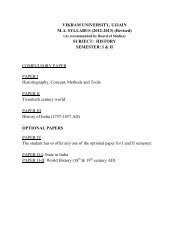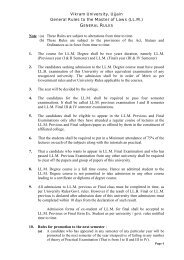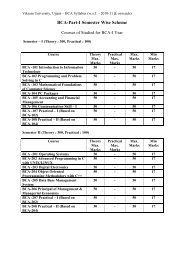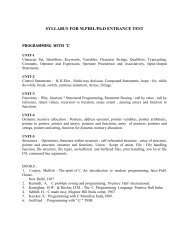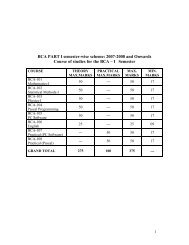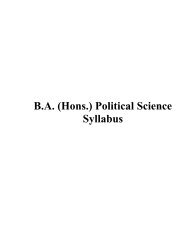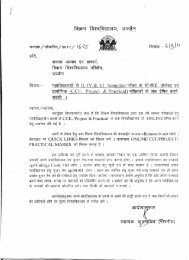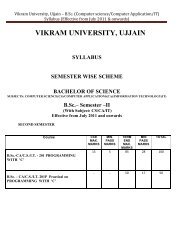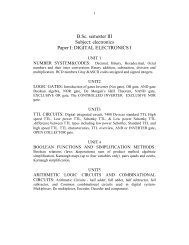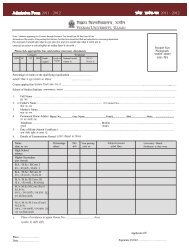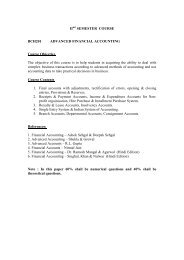Effective for 2011-12 batch - Vikram University
Effective for 2011-12 batch - Vikram University
Effective for 2011-12 batch - Vikram University
Create successful ePaper yourself
Turn your PDF publications into a flip-book with our unique Google optimized e-Paper software.
<strong>Vikram</strong> <strong>University</strong>, Ujjain – B.Sc. (Computer Science/IT) Syllabus<br />
(<strong>Effective</strong> <strong>for</strong> <strong>2011</strong>-<strong>12</strong> <strong>batch</strong>)<br />
VIKRAM UNIVERSITY, UJJAIN<br />
SYLLABUS<br />
SEMESTER WISE SCHEME<br />
BACHELOR OF SCIENCE<br />
SUBJECT: COMPUTER SCIENCE/IT<br />
B.Sc.– Semester –IV<br />
(With Subject: Computer Science/IT)<br />
<strong>Effective</strong> <strong>for</strong> <strong>2011</strong>-<strong>12</strong> <strong>batch</strong><br />
FOURTH SEMESTER<br />
Course<br />
CCE<br />
MAX.<br />
MARKS<br />
MIN.<br />
PASS<br />
MARKS<br />
TERM<br />
END<br />
MAX.<br />
MARKS<br />
MIN PASS<br />
MARKS<br />
TOTAL<br />
15 05 85 28 100<br />
B.Sc.-CS/IT- 401 DATA BASE MANAGEMENT SYSTEM<br />
- - 50 17 50<br />
B.Sc.-CS/IT- 401P DATA BASE MANAGEMENT SYSTEM
<strong>Vikram</strong> <strong>University</strong>, Ujjain – B.Sc. (Computer Science/IT) Syllabus<br />
(<strong>Effective</strong> <strong>for</strong> <strong>2011</strong>-<strong>12</strong> <strong>batch</strong>)<br />
B.SC.-CS/I.T.- 401 -DATA BASE MANAGEMENT SYSTEM [M.M. 85]<br />
UNIT I<br />
DBMS Concepts and architecture Introduction, Review of file organization techniques, Database<br />
approach v/s Traditional tile accessing approach, Advantages of database systems, Data models,<br />
Schemas and instances, Data independence, Functions of DBA and designer. Entities and<br />
attributes, Entity types, Value, Sets, Key attributes, Relationships, Defining the E-R diagram of<br />
database, Various data models : Basic concepts of Hierarchical data model, Network data model,<br />
and Relational data model, Comparison between the three types of models.<br />
UNIT II<br />
Relational Data models: Domains, Tuples, Attributes, Relations, Characteristics of relations,<br />
Keys, Key attributes of relation, Relational database, Schemas, Integrity constraints, Intension<br />
and Extension, Relational Query languages: Relational algebra and relational calculus, Relational<br />
algebra operations like select, Project, Join, Division, outer union etc.<br />
UNIT III<br />
Types of relational calculus i.e. Tuple oriented and domain oriented relational calculus and its<br />
operations. SQL: Data definition in SQL, update statements and views in SQL QUEL & QBE:<br />
Data storage and definitions, Data retrieval queries and update statements etc.<br />
UNIT IV<br />
Data Base Design: Introduction to normalization, Normal <strong>for</strong>ms, Functional dependency,<br />
Decomposition, Dependency preservation and losless join, problems with null valued and<br />
dangling tuples, multivalued dependencies.<br />
UNIT V<br />
Distributed databases, protection, security and integrity constraints, concurrent operation on<br />
databases, recovery, transaction processing, basic concepts of object oriented data base system<br />
and design. Case study of relational database management systems: Oracle and Microsoft access,<br />
Oracle tools.<br />
Books :<br />
1. Data Base Management System by C.J. Date<br />
2. Data Base Management System by Ullman<br />
3. Fundamental of database system by Elmasri / Navathe the Benjamin / Cunnings Publishing company inc.<br />
4. Data base design by Gio Wiederhold. McGraw Hill<br />
5. Fundamental of Data Base Management System by Leon & Leon, Vikas Publishing House Pvt. Ltd.



